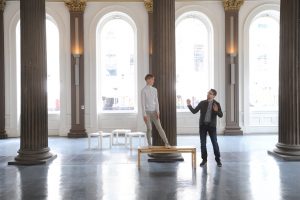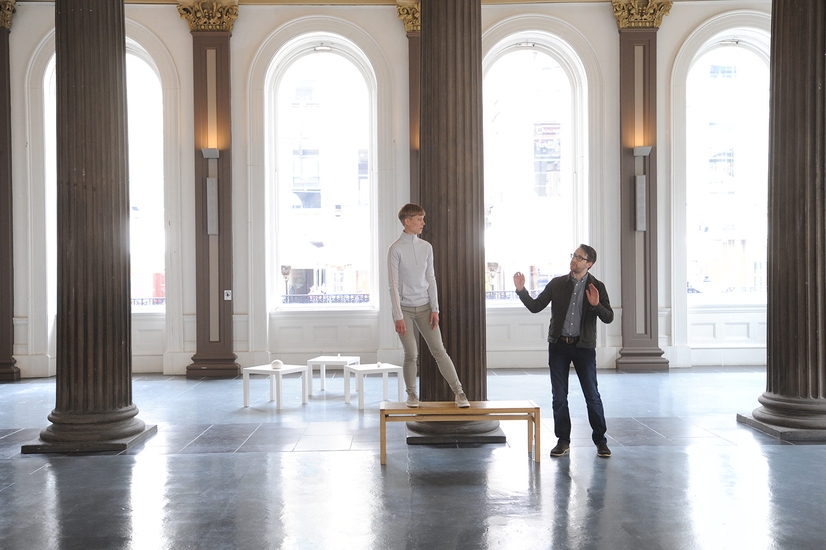Choreographer Siobhan Davies – who is known as Sue Davies – has been making choreographies since the 1970s. She first studied visual arts before discovering her love of dance at London Contemporary Dance Studios, swiftly moving into performing with the newly formed London Contemporary Dance Theatre, swiftly again into choreographing for the company – as well as for her own company Siobhan Davies and Dancers which she founded in 1981. A year later in 1982, with Richard Alston and Ian Spink, she formed Second Stride – a highly influential company in the independent British Dance scene through the 1980s.
The three choreographers had quite distinct voices: Alston’s work was lyrical and musical; Spink’s was more anarchic – playing with ambiguity in juxtaposing elements of dance, theatre and music; Davies’ work felt distilled – spacious – drawing your attention to movement – or dance – itself.
Three decades later she continues to investigate dance as an art form – or dance in itself. Her current work addresses relationships between dance and choreography through projects that question and seek to reveal the embodied actuality of dance and movement as the substance of the choreography.
It was with the opening of Siobhan Davies Studios in 2006, a home for the investigative arts organization Siobhan Davies Dance of which she is artistic director, that her work moved quite decisively away from theatre contexts and the touring model of production, towards investigative interdisciplinary approaches to choreographic making. Since then her work has been presented primarily in gallery type spaces and visual arts settings. The proximity of the audience to the work in these settings is conducive to her interest in exploring and revealing the embedded or embodied knowledge of the dancer. An example is Manual (2013) made in collaboration with dance artist Helka Kaski. In this work an audience member is invited by Kaski to help her perform an everyday task through giving her a series of verbal instructions. Within this shared experience of movement and conversation, the complexity of what is deeply known at an embodied level – by both performer and audience member – is brought into awareness. And an oddly caring encounter is performed.

Davies’s most recent project, material / rearranged / to / be (2017) a performance installation, comprises multiple pieces by choreographers, visual artists and designers – with scientists and academics also being an important resource in the development of the project. The work draws from the practices and image library of art historian Aby Warburg, his interest in gesture, in the placement of historically distanced images side by side – and in what kinds of relationships such placements might reveal. The project also continues Davies’ curiosities around revealing the embodied intelligence and communicative capacities of the body in acts of doing, as well as performers interacting with audience.
The list of contributors to the project extends to: dance artists Andrea Buckley, Siobhan Davies, Helka Kaski, Charlie Morrissey, Efrosini Protopapa, and Matthias Sperling; visual artists Jeremy Millar, Emma Smith, and design duo Glithero (Tim Simpson and Sarah van Gameren). Contributing fellows include Professor Jonathan Cole (neurophysiologist), Professor Guy Claxton (cognitive scientist), Dr. Scott deLahunta (dance theorist), Guido Orgs (cognitive psychologist) and Professor Anil Seth (neuroscientist).
Rosanna: You have previously spoken about the importance for you of the relation between between dancer and choreographer in the making of work – and that making happens in community. You have also spoken about the relation between dance and choreography – that there can be choreography without dance. With ‘material / rearranged / to / be’ [MRTB] many diverse inputs from different people are, in a way, curated within a collaborative installation. There is a very large and diverse community of makers, contributing works that sometimes, but not always, involve dance. In what ways does this project extend from your earlier works?
Sue: For MRTB I commissioned each individual artist and they own their work outright. From the outset we had chosen the subjects we wanted to work within during the making. We all wished to be conscious of how and what what everyone else was developing so that the collection of works would be coherent to an audience as they arrived and experienced the work.
In recent productions we had been developing ways of making that gave more authorship to the individual artists, but for MRTB we thought about it more as a group show of independent artists. Over the process I saw the evolution of distinct works finding their relationship amongst a collection which was growing around them. The different noticings, rhythms of making, use of materials was very exciting and occasionally daunting. In past works the lively and present interests of each artist was always valuable. In MRTB I wanted to increase the the volume of these.
For a long while the artists I was working with have been reading about and being in conversation with different neuro and cognitive scientists. We placed these interests at the core of the work while developing relationships with academics and curators based at the Warburg Institute, an organisation we knew very little about. We wanted to be challenged by these two poles of interest and wonderfully the further we worked the more aligned our findings from these two sources became.
Rosanna: I know you are passionate about the embodied knowledge of dancers and how embodied knowledge might be valued as richly as intellectual knowledge. How do you think such valuing might gain momentum?
Sue: I love the provocation which is part of Matthias Sperling’s ongoing practice in which he predicts that in the future there will be a Ministry of Choreography. We will see! But I really do believe that until we give credence and a less biased language which can demonstrate the role of the body as generator of knowledge in its feedback loop with the mind then we may not be able to address well enough the problems of this century. At the moment we isolate the mind and I believe lose how an integrated body informs us as an individual and among many. In a modest way I am attempting to unpeel how movement, dance and choreography can bring up different understandings of ourselves. Lever alternative perspectives on how we could sense more options and make better informed decisions.
Embodied can sound as if our understandings comes only from within our skins while I think of our bodies as both a receiver and playback. Oscillating all the time between messages coming in and being sent out from every molecule within us and to every molecule beyond. It is hugely exciting if I can only think about this for a few seconds! But I think I am, we are, actually doing this all the time.
In a modest way I am trying to make the natural links which exist between different modes of thinking. And ones which embrace what movement and choreography do, both as an art but also when our practice can be be applied to other fields.
We are also developing primary and young peoples programmes which ask them to think choreographically alongside dance or movement. I am less focussed on a possibly narrow vision of fitness. But I do think if we don’t foreground what it feels like to have or develop an articulate body which we can listen to as it teaches us to be, then we have edited out a huge resource for our development. The very young, the injured and the elder amongst us are far more sophisticated.
Rosanna: Your work in gallery spaces has involved public moving around or through such as with Rotor (2010). With Manual (2013) there was a shift into public participation – the work existed through the direct participation of the visitor. What brought you to this moment of participation?
Sue: I think it is a question of a step at a time. I learn and then I can see what might release something more and go and test that out
Both Helka and I were struck by the connections, both physical and conversational, which were created by the doing of ‘Manual’. Helka and the member of the public who had joined her to complete ‘Manual’ worked side by side, often in unconscious synchronicity and engaged in equal conversation. It will always be a key work for me because of the unforced closeness which rose up between the two.
Rosanna: Your website states that you are concerned with a contemporary definitions of choreography. Perhaps a driving force in your approach is towards a greater understanding of mind body connection and towards revealing ways that the body ‘knows’ – itself a contemporary concern shared by neuroscientists. How has working with scientist informed your work and your understanding of choreography and its place in society?
Sue: I have lived with and through dance for fifty years and I am super conscious that a lot of subjects that I feel I have some capacity to meet have come about because of the confidence given to me by studying movement and choreography.
When I worked with the architect Sarah Wigglesworth while she was designing our dance studios in London we could share our different knowledges and discuss them expansively. We could touch on the different anatomies of both a building and a body. The functional and the imaginative, the archives held in both and how we might think about our bodies and buildings receiving the investments of continuous thought, practice and process.
Concurrently to these conversations I was expanding my reading away from strictly anatomical books and more into trying to understand the use of imagery in dance making. If I imagined in a more embodied and present way the movement was simply more readable. I needed to bring my full and continuous consciousness to it. And what was that? Was it part of my body? What had I not been using? Or at least what parts of me had I involved but not been conscious enough of? And so began a reach into neuroscience – and some of these scientists were already intrigued by our application to movement and its composition. Some of these initial conversations are still going on and there have been many developments in both fields which make for more targeted research. There are more questions between us and at a simple level the conversations work as a stimulation, or as a challenge of perceptions. When a piece of actual peer-reviewed science research happens then the onus has to be far more on the science than the art.
I have learnt to see the whole of us as an enormous orchestration of events. This could give me a huge capacity to make complex movement but also lets me approach simple movement as a wonder. I have enjoyed focussing on something we are all aware of. For example standing up, using gesture, the gaining of movement and memory and then the remembering of forgotten movement archived within us and the experience of memory welling up from a place we might want more contact with.
Rosanna: Thank you!
Notes
Image of Manual by Alan Dimmick, courtesy Glasgow Life
Interview date 20th April 2017



